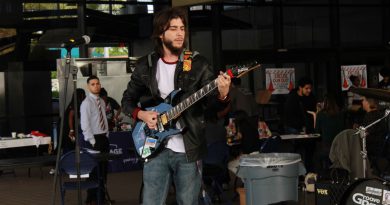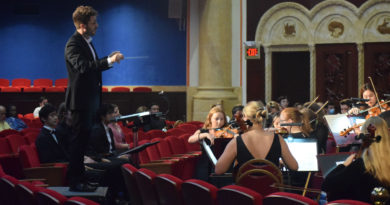Mexico Shows Miami Dade College Students A Sustainable City

Preventing Disasters: (From L to R) Sue McClam, Samantha Blain and Carmen Audever plant anti-erosion grass alongside the borders of El Derramadero school on May 3.
For six students, an eco-tourism and sustainability trip to Mexico was more than a way to participate in service activities in rural bay areas while learning sustainable and cultural perspectives. As one of those students, I jumped at the opportunity to take an eight day trip to meet and help people in Huatulco, Mexico, located on the country’s southern Pacific coast.
On the first morning of the trip, May 1, our departure started early—7 a.m. A two hour flight from Miami to Mexico City with a three hour layover, followed by a six hour trip from Mexico City to Huatulco was a mix of exhaustion, overwhelming feelings and bursts of excitement.
Upon arrival, Sue McClam, our guide, gave the group a short, Spanish lesson that would help us speak to people of the region. That night we cheered after enjoying our first authentic Mexican dinner and returned back to the posada, a family owned inn.
The next few days consisted of visiting different destinations, including the Hagia Sofia Agro-Ecological Development Center, national parks, the indigenous coastal village Barra de la Cruz, and an indigenous village located more inland called Derramadero.
On a mission to be more than tourists, we spent days learning about the real situation in Huatulco. We became aware of the government’s plans to build hotels and destroy natural landmarks.
Our group met The Green Team, an organization that focuses on helping Huatulco stay the leading sustainable tourism community in the world. To assist, we went up to the mountains near the Derramadero region and planted anti-erosion grass along the border of a school.
Later that day, we sat down with the school children to teach them words in English using toys and pictures. Being involved with the children was not only fun but rewarding. When we left they were all happy.
Teaching English wasn’t all we did. When our group went to Barra de la Cruz, along the coast, we plucked vegetables and picked up egg cartons, shoes, and ripped clothes from the beach.
One of my favorite days was when we visited the agro-ecological botanical garden, the Hagia Sofia. The garden is 333 acres but only 33 are in use. Mountains roll over each other and reach up to kiss the beautiful blue sky. Hummingbirds flew around us, creating the sound of a mini motorcycle zooming by.
We observed debates on different topics about the environment from the green team. It was interesting to see the perspective they had on agriculture.
On day seven, we visited an eco-archeological park and got the chance to see different archeological sites.
As we said our goodbyes on the eighth day, I felt different. We knew what it took for a city to become sustainable. Now that we have that knowledge, we’re capable of so much more than when we first stepped foot in Huatulco.




